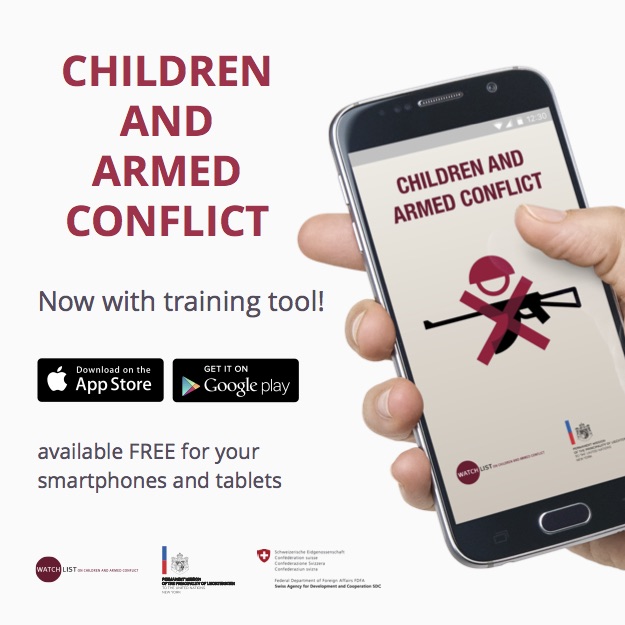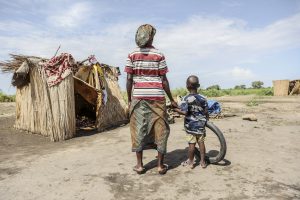D. R. Congo
Advocacy
This information is based on Watchlist’s Children and Armed Conflict Monthly Update – June 2025.
In October, the SG released his ninth report (S/2024/705) on the situation of CAAC in the DRC, covering the period from April 2022 to March 2024. During this period, the CTFMR verified 8,208 grave violations against 6,196 children (4,325 boys, 1,871 girls) by 77 parties, representing an eight percent increase from the previous report. Non-State armed groups were responsible for 98 percent of verified violations, while Government forces were responsible for two percent (187). Recruitment and use (4,006), abduction (2,028), and killing and maiming (1,298) were the most verified violations. While rape and other forms of sexual violence (662) and attacks on schools and hospitals (193) saw a 30 percent decrease, all other grave violations increased, with alarming rises in abduction (31 percent), killing and maiming (40 percent), and denial of humanitarian access (62 percent). Sexual violence continued to be the violation most attributed to Government forces, primarily the FARDC. The CTFMR also verified the detention of 142 children for alleged association with armed groups, as well as 55 incidents of the military use of schools. The reporting period was marked by a deteriorating security and humanitarian situation, increased fighting between the FARDC and the resurgent M23 in North Kivu, as well as the beginning of MONUSCO’s gradual withdrawal. The Working Group should:
- Strongly condemn all continuing violations and abuses committed against children in the DRC, express grave concern at the increase in verified grave violations against children, and demand that all parties uphold their obligations under IHL and IHRL;
- Welcome the Government’s continued efforts to consolidate the gains of the 2012 action plan, call for the swift and full operationalization of the national strategy for implementation of the Demobilization, Disarmament, Community Recovery, and Stabilization Program (P-DDRCS), integrating gender-specific considerations to address the needs of girls associated with armed groups and armed forces;
- Call on Member States and donors to support and ensure predictable funding for child protection efforts in light of the phased withdrawal of MONUSCO;
- Urge all armed groups to immediately release all children under 18 from their ranks and end and prevent all child recruitment and use; reiterate that children associated with armed forces and groups should be treated primarily as victims and call on the Government to ensure children formerly associated with armed groups are handed over to civilian child protection actors in compliance with its 2013 directives and the Paris Principles;
- Call on all parties to take immediate and specific steps to end and prevent rape and other forms of sexual violence against children, including by ensuring perpetrators are held accountable and that survivors have access to comprehensive, gender-sensitive, and age-appropriate response and protection, and call on the Government to accelerate efforts to implement aspects of its 2012 action plan relating to sexual violence and the Joint Communiqué signed with the UN to fight sexual violence in conflict;
- Call on all parties to immediately cease attacks and threats of attack on educational and health facilities and personnel, as well as to refrain from the military use of schools, and encourage the Government to follow up on implementation of its 2017 Safe Schools Declaration roadmap.
This information is based on Watchlist’s Children and Armed Conflict Monthly Update – December 2024.
Partnerships
In the Democratic Republic of Congo, Watchlist has provided support via its Partnerships Program in order to strengthen local efforts to monitor, report on, and respond to grave violations against children. This support has included timely outreach and trainings for local civil society actors in Eastern DRC. Watchlist currently provides technical support, including mentoring, to one local organization in the DRC. Working through community-based protection committees, Watchlist’s partner monitors and documents child rights violations. They also engage with local authorities to improve access to referral services and to prevent violations.
Publications
UN Action
Year listed: 2003
Action Plans signed: FARDC (the Armed Forces of the Democratic Republic of the Congo) – recruitment and use of children and sexual violence against children (October 2012) *Delisted in 2017 following compliance with Action Plan to end and prevent the recruitment and use of children. Action Plan on ending and preventing sexual violence against children under implementation.
Sanctions Committee: Sanctions Committee concerning Democratic Republic of Congo (Current Chair: Niger)
Secretary-General’s reports on CAAC in DRC: 2022; 2020; 2018; 2014; 2010; 2008; 2007; 2006
Security Council Working Group conclusions on DRC: 2020; 2018; 2014; 2011; 2009; 2007; 2006
UN Mission: MONUSCO
Perpetrators listed in the annexes of the Secretary-General’s annual reports on children and armed conflict
| 2001 | 2002 | 2003 | 2005 | 2006 | 2007 | 2009 | 2010 | 2011 | 2012 | 2013 | 2014 | 2015 | 2016 | 2017 | |
|---|---|---|---|---|---|---|---|---|---|---|---|---|---|---|---|
| Government of the Democratic Republic of the Congo | a | ||||||||||||||
| Forces armees congolaises (FAC) | a | ||||||||||||||
| Forces armees de la Republique Democratique du Congo (FARDC)~* | a | a,b,c,e | a,b,c,e | a,c,d,f | a,c | a,c | a,c | a,c | a,c | a,c | a,c | c | |||
| Mouvement national de liberation du Congo (MLC) | a | a | |||||||||||||
| Rassemblement congolais pour la democratie (RCD)-Goma | a | a | |||||||||||||
| Local defence forces associated with RCD-Goma | a | ||||||||||||||
| Rassemblement congolais pour la democratie (RCD)-National | a | a | |||||||||||||
| Rassemblement congolais pour la democratie (RCD)-Kisangani/ML | a | a | |||||||||||||
| Union des patriotes congolais (UPC) (Hema militia) | a | a | |||||||||||||
| Union des patriotes congolais (UPC)-Thomas Lubanga and Florimert Kisembo factions | a | ||||||||||||||
| Parti pour l’unite et la sauvenarge du Congo (PUSIC) (Hema Militias) | a | a | |||||||||||||
| Masunzu’s forces | a | a | |||||||||||||
| Lendu militias | a | ||||||||||||||
| Front nationaliste et integrationaliste (FNI) (Lendu) | a | a,b | a | a,e | a | a,c | a,c | ||||||||
| Front populaire pour la reconciliation de l’Ituri (FPRI) (Ngiti) | a | ||||||||||||||
| Ex-FAR/Interahamwe | a | a | |||||||||||||
| Mai-Mai | a | a | |||||||||||||
| Mai-Mai in the Kivus, Maniema and Katanga | a,b | ||||||||||||||
| Mai-Mai groups in North and South Kivu, Maniema and Katanga who have not integrated into FARDC | a | a,e | |||||||||||||
| Union des patriotes congolais pour la paix (also known as Mai-Mai Lafontaine)* | a,d,f | a,c | a,c | a,c | a | a | a | a | a | ||||||
| Alliance des patriotes pour un Congo libre et souverain* | a | a | a | a | a | ||||||||||
| Mai-Mai Simba* | c | a,c | a,c | a,c | a,c | ||||||||||
| Mai Mai “Tawimbi” | a | ||||||||||||||
| Forces armes populaires congolaises (FAPC) | a | a,b | |||||||||||||
| Mudundu-40 | a | a | |||||||||||||
| Laurent Nkunda and Jules Mutebutsi, dissident elements of FARDC | a,c | ||||||||||||||
| Non-integrated FARDC elements loyal to rebel leader Laurent Nkunda | a,e | a,b,c,e | |||||||||||||
| Forces démocratiques de libération du Rwanda (FDLR)* | a,b,c | a,e | a,b,c,e | a | a,c | a,c | a,c,d | a,c,d | a,c,d | a,c,d | a,c,d | a,c,d,e | |||
| Force de résistance patriotique de l’Ituri (FRPI)*/Front Populaire pour la Justice au Congo (FPJC) | a,e | a,c | a,c | a,c | a,c | a,c,d | a,c,d | a,c,d | a,c,d,e | ||||||
| Mouvement revolutionnaire congolais (MRC) | a,e | ||||||||||||||
| Congres national pour la defense du peuple (CNDP), formerly led by Laurent Nkunda and now Bosco Ntaganda | a,b,d | a,c | a,c | a,c | |||||||||||
| Lord’s Resistance Army (LRA)* | a,b,c,e | a,c | a,c | a,c | a,b,c | a,b,c | a,b,c | a,b,c,e | a,b,c,e | ||||||
| Mouvement du 23 Mars (M23) | a,c | a,c | |||||||||||||
| Allied Democratic Forces (ADF) | a,d | a,b,d | a,b,d | a,b,d,e | |||||||||||
| Mai-Mai Kata Katanga | a | a | a | a | |||||||||||
| Nduma défense du Congo-Rénové/Mai-Mai Cheka | a,b | a,b | a,b | a,b | |||||||||||
| Nyatura | a | a | a | a | |||||||||||
| Raia Mutomboki | a,c | a,c | |||||||||||||
| Mai-Mai Mazembe | a,b |
a: Parties that recruit and use children
b: Parties that kill and maim children
c: Parties that commit rape and other forms of sexual violence against children
d: Parties that engage in attacks on schools and/or hospitals
e: Parties that engage in abduction of children
f: Parties that deny humanitarian access to children
~ This party has concluded an action plan with the United Nations in line with Security Council resolutions 1539 (2004) and 1612 (2005).
* This party has been in the annexes for at least five years and is therefore considered a persistent perpetrator.




